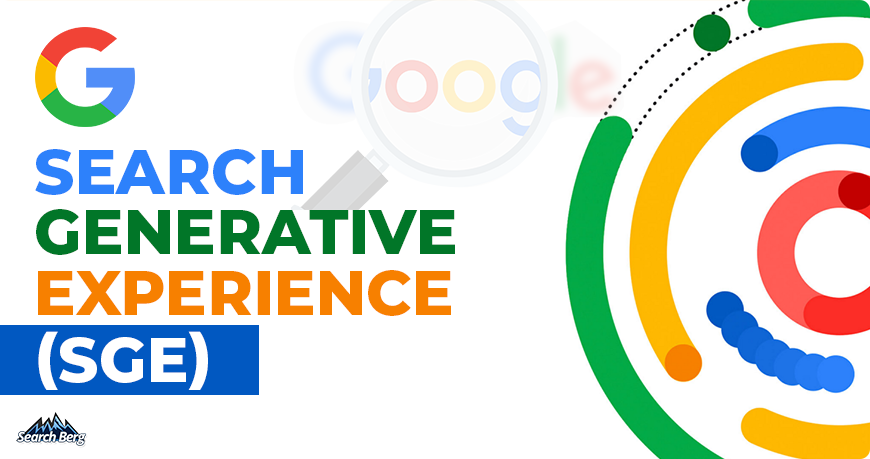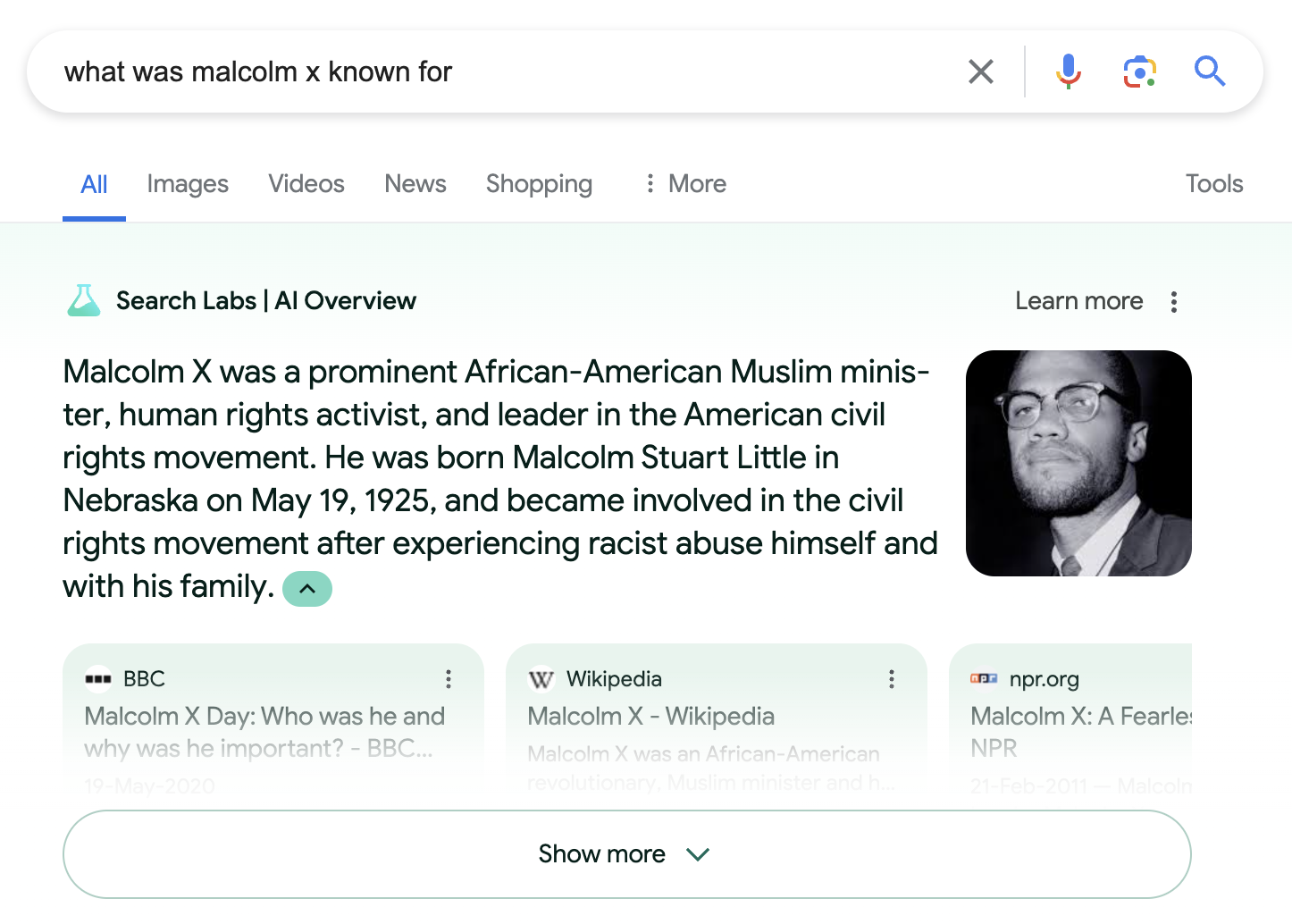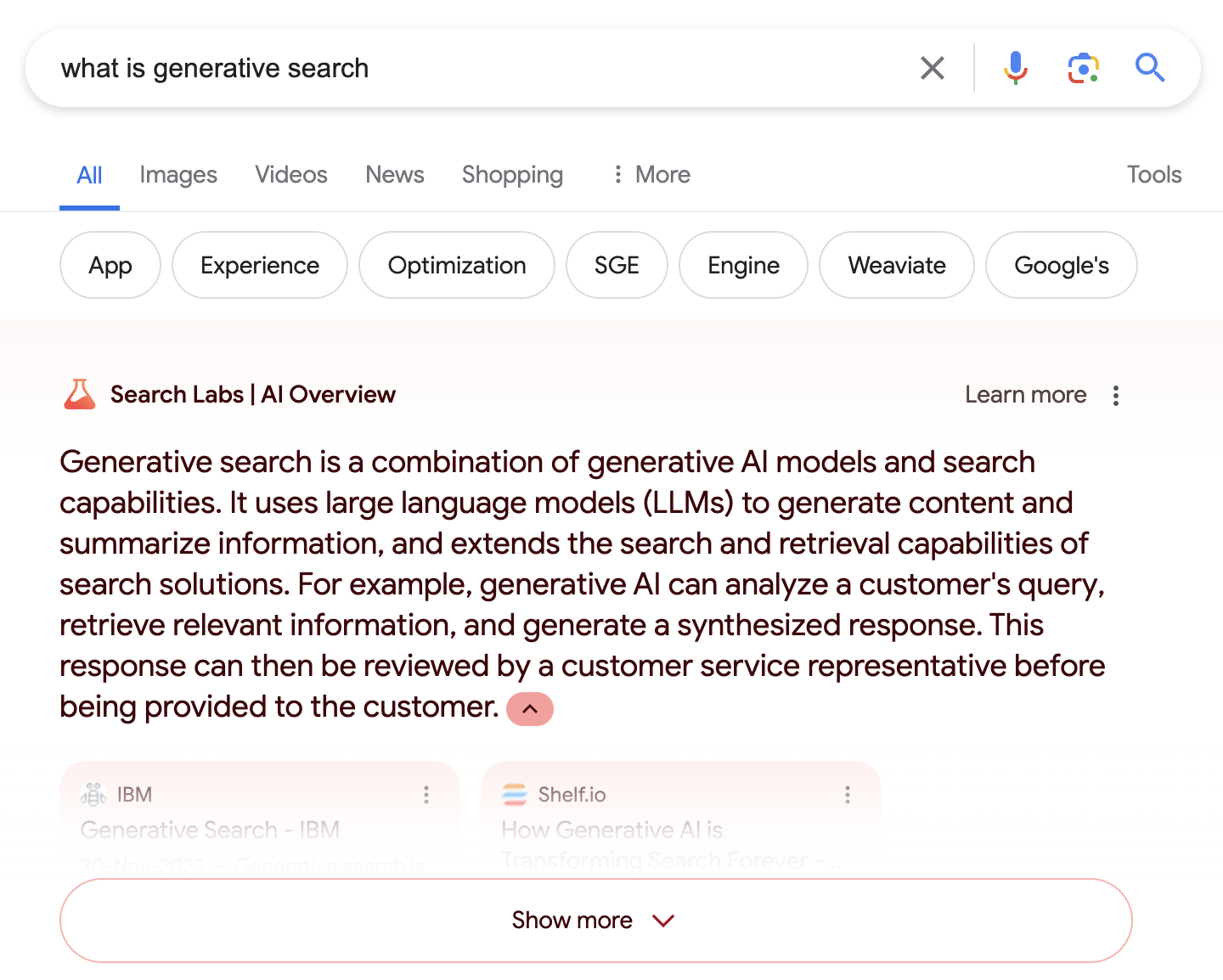How to Achieve Guaranteed SEO with Google’s Search Generative Experience (SGE)

Move over, old-school SEO; there’s a new player in town, and it’s got everyone buzzing.
Google’s Search Generative Experience (SGE) is a seismic shift in the search landscape. This AI-powered dynamo is transforming how Google delivers answers, making traditional SEO tactics feel like last season’s playbook.
But here’s the kicker: SGE isn’t a threat to your rankings; it’s actually a golden opportunity. By understanding its intricacies and adapting your strategy, you can harness its power to achieve what was once considered impossible: guaranteed SEO.
In this blog post, we’ll break down the SGE playbook, revealing the strategies, tactics, and insider knowledge you need to thrive in this new era of search. We’ll show you how to create SGE-optimized content that stands out, outranks the competition, and drives a steady stream of organic traffic to your website.
Forget the guesswork and outdated tactics. We’re about to equip you with strategies that give you guaranteed search engine rankings.
What Exactly is Google’s Search Generative Experience (SGE)?
Powered by advanced artificial intelligence, SGE aims to provide users with more comprehensive, nuanced answers directly on the search engine results page (SERP).
Think of it as a knowledgeable assistant that sifts through the vastness of the internet, synthesizes relevant information, and presents it in a concise, easy-to-understand format.
But why should businesses care?
Here’s why.
- A New Way to Answer Questions: Google SGEis several steps ahead of traditional keyword matching. It can understand the intent behind complex queries and pull insights from various sources to create a holistic answer. This means your content can’t just be keyword-optimized; it must carefully and precisely address the nuances of user intent.
- AI-Powered Overviews: For many queries, SGE generates “AI snapshots,” i.e., concise summaries of key information complete with links to relevant sources. These snapshots often appear at the top of the SERP, potentially pushing down traditional organic results.
Here are a few examples:



- Conversational Search: SGE allows users to ask follow-up questions in a conversational mode, keeping context from previous interactions. This means your content must be structured in a way that answers the initial query and potential follow-up questions.
- Prioritizing Expertise and Authority: SGE heavily emphasizes the E-E-A-T principle (Experience, Expertise, Authoritativeness, and Trustworthiness). Websites with a proven track record of providing accurate, reliable information are more likely to be featured in SGE’s responses.
- Impact on SEO: SGE is still in its experimental phase, but its impact on SEO is undeniable. Traditional SEO tactics like keyword stuffing and link building are becoming less effective. Instead, the focus is shifting towards creating high-quality, comprehensive content that aligns with SGE’s preferences.
By adapting your SEO strategy to accommodate SGE, you can position your content to be featured in those coveted AI snapshots. You’ll gain maximum visibility and drive organic traffic.
This is also an excellent chance to showcase your expertise and build trust with both Google and your audience. By aligning your content with SGE’s conversational nature, you can provide a seamless search experience that keeps users engaged with your brand.
6 Techniques to Rework Your Content for Guaranteed Search Engine Rankings with SGE
1. Prioritize Comprehensive, In-Depth Content
The days of thin, superficial content peppered with keywords are long gone. Google SGE craves quality, i.e., substance, depth, and a comprehensive understanding of the topic at hand. This doesn’t mean churning out lengthy essays for the sake of it; it means providing value to the user with every word.
Think of your content as a multi-course meal, not a quick snack. Each section should serve a purpose, answer potential questions, offer unique insights, and leave the reader feeling satisfied and informed. This is where the concept of “pillar content” comes into play. Pillar content is comprehensive, authoritative content that covers a core topic in depth. It serves as a central hub for related content.
For example, if you run a fitness business, your pillar content could be a comprehensive guide to weight loss. This guide would cover everything from the science of weight loss to practical tips and strategies. You can then create cluster content from this pillar, i.e., shorter, more focused content that delves into specific aspects of weight loss, e.g., the benefits of strength training or the importance of sleep.
What kind of pillar content can you come up with?
Here’s a better understanding.

By creating a network of interconnected content, you’ll provide value to your audience and signal to SGE that you’re an expert in your field. This is essential, as SGE heavily favors content from authoritative sources. When SGE encounters a query related to your niche, it’s more likely to pull information from your comprehensive pillar content and related clusters. This will increase your chances of securing a coveted spot in the AI-powered snapshot.
But depth isn’t just a matter of quantity; quality is just as important. Your content should be well-researched, accurate, and up-to-date. SGE has a knack for sniffing out outdated or inaccurate information, so make sure your facts are solid and your sources are credible. Additionally, your content should be engaging, relevant, and well-written. It must keep readers hooked from start to finish.
Keep in mind that Google SGE is designed to understand the nuances of human language and intent. This means your content must be written in a natural, conversational style that resonates with your target audience. Avoid jargon and technical terms unless absolutely necessary, and focus on communicating your message clearly and effectively.
What if you’re in a niche where in-depth content is limited? Nothing to worry about. Even in highly specialized fields, there are always opportunities to go deeper. You can explore the history of your industry, delve into emerging trends, or offer unique perspectives on common challenges.
The key is to think beyond the obvious and provide insights that your competitors haven’t. This is what will set you apart in the eyes of both SGE and your target audience. By prioritizing comprehensive, in-depth content, you’re not just playing the SEO game; you’re winning it.
Recommended Read: Google’s March 2024 Core Update: 8 Ways Search Berg is Keeping Its Clients Afloat
2. Optimize for SGE’s Conversational Nature
Imagine having a conversation with a search engine that understands the nuances of your questions and responds with insightful answers tailored to your needs. That’s the experience Google’s Search Generative Experience (SGE) is going for, and it’s changing the way we approach SEO.
SGE is designed to understand natural language queries, including those posed in a conversational style. This means you can ask follow-up questions, seek clarification, or explore related topics without having to rephrase your search or start from scratch. To optimize for SGE’s conversational nature and bag the first-page SEO guarantee, your content must mimic this conversational flow.
Start by anticipating your target audience’s questions. What are their pain points? What information are they seeking? Use these questions to guide your content creation. You must provide comprehensive answers that address all aspects of the topic.
For example, if you’re writing about “how to choose the right running shoes,” don’t just list features and benefits. Anticipate questions like “What type of shoe is best for my foot type?” or “How often should I replace my running shoes?” By addressing these questions proactively, you’ll provide valuable information and demonstrate to SGE that your content is comprehensive and relevant to a range of user queries.
Another key aspect of optimizing for SGE’s conversational nature is using structured data and schema markup. This helps SGE understand the context of your content, making it easier to extract relevant information and present it in a conversational format. For instance, if you’re working on a recipe, using schema markup can help SGE identify the ingredients, cooking time, and other relevant details, allowing it to provide a concise summary in response to a user’s query.
We also recommend using questions in your content. This is a great way to break up the text and make it more engaging. It also signals to SGE that you’re anticipating user queries and providing relevant answers. For example, instead of simply stating a fact, rephrase it as a question: “Did you know that 80% of consumers are more likely to purchase from brands that provide personalized experiences?” This conversational approach can help capture the reader’s attention and encourage them to continue reading.
3. Focus on E-E-A-T Principles
SEO has evolved massively in the past decade, but one thing has remained constant: the importance of trust and credibility. This is where Google’s E-E-A-T principle comes into play.
E-E-A-T stands for experience, expertise, authoritativeness, and trustworthiness, and it’s a core element in Google’s search quality rating guidelines.
With the introduction of Google’s Search Generative Experience (SGE), E-E-A-T has become even more important. SGE is designed to understand and prioritize content that demonstrates a high level of expertise and trustworthiness. If your content is E-E-A-T-friendly, i.e., it demonstrates a high level of expertise and trustworthiness, then you’re on your way to achieving guaranteed search engine rankings.
But what does E-E-A-T mean in practical terms, and how can you optimize your content accordingly?
Let’s break it down:
- Experience: This refers to first-hand or life experience related to the topic. For example, a travel blogger who has personally visited a destination is more likely to be considered experienced than someone who has only read about it.
- Expertise: Expertise refers to the knowledge and skills you possess in a particular field. This can be demonstrated through formal qualifications, professional experience, or a proven track record of success.
- Authoritativeness: Authoritativeness is about being recognized as a reliable and trustworthy source of information. This can be achieved through backlinks from reputable websites, mentions in industry publications, or positive reviews from customers.
- Trustworthiness: Trustworthiness refers to being honest, transparent, and reliable. This includes providing accurate information, disclosing any conflicts of interest, and having a secure website with a valid SSL certificate.
By focusing on these four pillars of E-E-A-T, you can signal to Google that your content is high-quality, reliable, and worthy of a top spot in on Google SERPs. But how can you practically implement E-E-A-T into your content strategy?
To showcase experience, consider sharing case studies, testimonials, or even personal anecdotes that demonstrate your first-hand knowledge of the topic. If you’re a financial advisor, for instance, sharing a case study of how you helped a client achieve their financial goals can be a powerful way to showcase your experience.
Building expertise involves highlighting your writers’ credentials and qualifications. Include author bios with relevant degrees, certifications, or years of experience. If you have a team of experts, showcase their individual expertise through detailed profiles or “meet the team” pages.
Establishing authoritativeness is a little tricky, but it can be achieved through a multi-pronged approach. Seek out opportunities to guest post on reputable websites in your industry. Engage in thought leadership by speaking at conferences or webinars. Encourage positive reviews and testimonials from satisfied customers. All of these actions contribute to building your brand’s authority in Google’s and your target audience’s eyes.
Trustworthiness is perhaps the most integral element of E-E-A-T, especially in the age of Google SGE. Your website must be secure with a valid SSL certificate. Be transparent about your business practices, privacy policies, and any potential conflicts of interest. Provide accurate, up-to-date information and cite reputable sources to back up your claims.
By meticulously addressing each aspect of E-E-A-T, you’ll enjoy guaranteed rankings and build a solid foundation for long-term SEO success. A website that exudes experience, expertise, authoritativeness, and trustworthiness is also more likely to attract and retain loyal customers.
Recommended Read: SEO Content Guide to Search Engine Ranking Factors
4. Enhance User Experience
In the quest for guaranteed search engine rankings, businesses often focus on keywords, backlinks, and technical SEO. However, with Google SGE changing the game, there’s another essential factor that can make or break your SEO success: user experience (UX).
SGE is designed to understand and prioritize content that provides informative answers and delivers a seamless, enjoyable experience for users. This means that if your website is clunky, slow to load, or difficult to navigate, you’ll frustrate your audience and reduce your chances of securing a first-page SEO guarantee.
Think of it this way: SGE is like a discerning visitor who quickly assesses your website’s value. If it encounters a confusing layout, broken links, or walls of text, it’s likely to move on to a more user-friendly option. This will affect your chances of being featured in SGE’s AI-powered overviews and reduce your overall search engine ranking.
So, how can you enhance user experience and make SGE fall in love with your website?
For starters, prioritize website speed. In 2024, users expect websites to load quickly. A slow-loading site leads to high bounce rates and signals to SGE that your website isn’t providing a good user experience. Invest in a reliable hosting provider, optimize your images and code, and utilize caching techniques to ensure your website loads in a flash.
Next, it’s time to focus on mobile-friendliness. With more and more users accessing the internet on their smartphones, your website must be responsive and easy to navigate on smaller screens. The text must be readable, the buttons should be easy to tap, and the images must be optimized for mobile viewing. Google’s mobile-first indexing means that Google primarily uses your site’s mobile version for ranking. If your site is mobile-friendly, you’ll get closer to that coveted first-page SEO guarantee.
Navigation is another critical aspect of UX. Your website’s structure should be intuitive and easy to follow. Web users must be able to find the information they need quickly and easily. Use clear headings, descriptive labels, and a well-organized menu to guide users through your site. Don’t forget to include a search bar to help users find specific content.
Readability is equally important. Break up long blocks of text into shorter paragraphs, use subheadings to organize your content, and choose a font that’s easy on the eyes. Consider incorporating visuals like images, infographics, or videos to break up the text and make your content more engaging.
Finally, you can’t ignore accessibility. Your website must be designed in a way that it can be easily used by people with disabilities. This includes providing alternative text for images, using color contrast that’s easy to read, and offering keyboard navigation options.
5. Focus on Long-Tail Keywords
While traditional SEO often focuses on short, high-volume keywords, Google’s Search Generative Experience (SGE) demands a more nuanced approach. SGE’s ability to understand natural language and conversational queries means that long-tail keywords and voice search optimization are now more important than ever for achieving guaranteed search engine rankings.
Why do long-tail keywords matter in the SGE era? Here’s why:
- Specificity: Long-tail keywords are more specific and targeted than generic, high-volume keywords. This means they attract users who are further along in the buying journey and are more likely to convert. For example, instead of targeting “shoes,” you could target “best running shoes for flat feet.”
- Lower Competition: Long-tail keywords typically have lower search volumes, which means they’re less competitive and easier to rank for. This is especially beneficial for smaller businesses or websites with limited SEO resources.
- Alignment with SGE: SGE’s conversational understanding allows it to grasp the intent behind long-tail keywords more accurately. By incorporating these phrases into your content, you’re essentially speaking SGE’s language and increasing your chances of appearing in its responses.
Weaving long-tail keywords into your content is an art that blends strategy with finesse. We’re not asking you to shoehorn phrases in awkwardly. Instead, master the art of creating a natural flow that both search engines and readers appreciate.
Start by strategically placing long-tail keywords in your titles, headings, and subheadings. This will help SGE quickly identify the focus of your content. It’ll also make it easier for users to scan and navigate your page.
However, don’t limit yourself to these prominent positions. Sprinkle long-tail keywords throughout the body of your content. Use them in a way that feels organic and enhances the overall readability.
Let’s say you run a travel agency that specializes in eco-tourism. Instead of targeting a broad term like “vacation destinations,” you could hone in on long-tail keywords like “best sustainable travel destinations for families” or “affordable eco-friendly resorts in Costa Rica.” This way, you’ll attract a more specific audience that’s genuinely interested in your niche. Your content will also align with the way people naturally phrase their voice searches.
Remember, Google SGE is designed to understand the intent behind a search query. Instead of simply repeating the same long-tail keyword over and over again, vary your language and use synonyms or related phrases. This will make your content more engaging and help SGE recognize the breadth and depth of your topic coverage.
Never ignore context. When using long-tail keywords, make sure they fit seamlessly within the surrounding text. The goal is to provide valuable information that answers the user’s query while naturally incorporating the relevant keywords.
6. Embrace Voice Search

With the rise of smart speakers, voice assistants, and voice-enabled devices, more and more users are opting for the convenience and speed of voice commands. This vocal revolution has profound implications for SEO, especially in the era of Google’s Search Generative Experience (SGE).
SGE’s advanced natural language processing capabilities make it particularly adept at understanding and responding to voice search queries. This means that optimizing your content for voice search isn’t just a nice little add-on; it’s a necessity for achieving guaranteed search engine rankings in the SGE landscape.
So, how can you make your content voice search-friendly and tap into this growing segment of users?
Start by adopting a conversational tone in your writing. People tend to speak more naturally when using voice search. They often phrase their queries as questions or use longer, more descriptive phrases. By mirroring this conversational style in your content, you’re essentially speaking Google SGE’s language and increasing your chances of appearing in voice search results.
Local SEO is also essential for voice search optimization. Many voice searches have local intent, e.g., “Find a coffee shop near me” or “What’s the weather like today?” Make sure your website is optimized for local SEO, including your NAP (name, address, phone number) information and relevant local keywords. This will help your business appear in voice search results when users are looking for products or services in your area.
Creating dedicated FAQ pages is another effective way to cater to voice search. These pages allow you to directly answer common questions that web users may ask through voice search. Structure your content in a Q&A format; use natural language and address a wide range of potential queries. This is a great way to make your content more accessible for voice search. And, of course, you’ll also end up providing valuable information to users, which is always the goal.
SGE’s Limitations and What Businesses Must Be Vary Of
While Google’s Search Generative Experience (SGE) presents exciting opportunities for businesses to enhance their SEO and reach a wider audience, it’s important to acknowledge its limitations. Understanding these limitations can help you set realistic expectations and develop strategies to mitigate potential challenges.
One of the primary limitations is the potential for misinterpretations during corroboration. While SGE strives to identify high-quality web results that support its AI-generated responses, there may be instances where it slightly misinterprets the language, resulting in a change in the meaning of the output. This can affect the accuracy and relevance of the information presented to users. It may even potentially impact their perception of your brand if your content is cited incorrectly. This is why you must work with experts who have a good grasp of SGE, its technicalities, and its evolving nature.
Another limitation is the possibility of hallucination, a common issue with large language models (LLMs). SGE, like other LLM-based experiences, may occasionally misrepresent facts or inaccurately identify insights. This can be particularly problematic for businesses whose credibility relies on providing accurate and reliable information. If your content is misrepresented by SGE, it could damage your reputation and undermine user trust.
Bias is another concern with Google SGE. The data used to train SGE is based on high-quality web-extracted data, which can sometimes exhibit narrow representations of people or potentially negative contextual associations. Despite Google’s efforts to apply safety and bias prevention guardrails, some biases may still seep through, resulting in potentially skewed or unfair results. This can be particularly harmful for businesses targeting diverse audiences, as biased responses may alienate certain groups and limit your reach.
Additionally, SGE may sometimes generate responses that appear to reflect opinions or emotions, even though it’s designed to maintain a neutral, objective tone. This can occur because the model is trained on human language, which naturally includes expressions of opinions and emotions. While SGE strives to avoid reflecting a persona, these instances can still occur, potentially resulting in confusion or misinterpretation among users.
The potential for duplication or contradiction with existing search features is another challenge. Since SGE is integrated into Google Search alongside other results and features, there may be instances where its output seems to contradict other information on the search results page. For instance, a featured snippet may highlight a single source’s perspective, while SGE presents a synthesized view corroborated by multiple sources. This can create confusion for users and make it difficult to determine the most accurate and reliable information.
As a business, you must be aware of these limitations and their potential impact on your SEO efforts. A complete, realistic, and factual understanding of SGE will help you fine-tune your SEO strategy and put your best foot forward for optimal results.
It’s Time to Master SGE with Search Berg
Google’s Search Generative Experience (SGE) is a complex beast; mastering its intricacies requires more than just guesswork and crossed fingers. To achieve guaranteed search engine rankings, you need a deep understanding of SGE’s algorithms, a mastery of its preferred content formats, and the ability to adapt your SEO strategy in real-time.
Trying to “wing it” on your own may result in missed opportunities, wasted resources, a frustrating lack of results, or serious damage to your rankings. The stakes are too high to leave your SEO to chance. Working with a seasoned expert like Search Berg is the smart way to secure your spot at the top of the search results.
At Search Berg, we’ve immersed ourselves in the world of SGE. Our experts have dissected its algorithms, studied its preferences, and developed proven strategies to help our clients achieve guaranteed SEO. We constantly monitor the latest SGE updates and trends to maintain a cutting-edge, effective, and tailored approach for our clients.
Our guaranteed SEO services are tailored to your specific needs and goals. Whether you need help crafting SGE-optimized content, improving your website’s user experience, or building authoritative backlinks, we have the expertise and experience to deliver results. With Search Berg in your corner, you can rest assured that your SEO strategy is in the hands of professionals who understand the nuances of SGE and are committed to helping you achieve the one thing that matters most: Google’s first-page SEO guarantee.
Let’s get the ball rolling!
[blog_form6]
Your Rankings Are on Us!
Guaranteed SEO isn’t a shot in the dark. It’s a calculated, precise SEO game plan that leaves you with high rankings, enviable traffic, and extraordinary conversions. We don’t just promise search engine visibility; we give you the first-page SEO guarantee.
Sounds like something your business needs? We’re here to provide it. And it all starts with a free proposal!
No spam, just expert advice!













